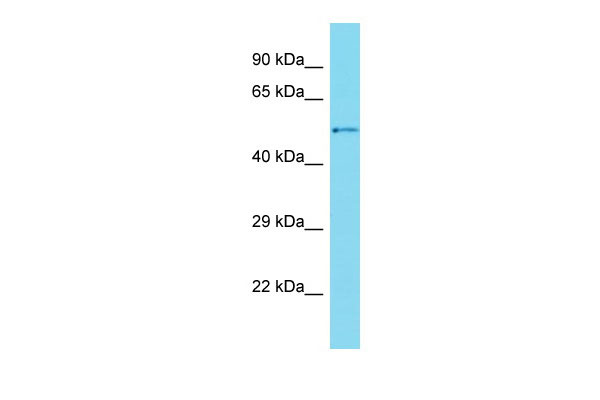SPRTN Antibody - middle region
Rabbit Polyclonal Antibody
- 产品详情
- 实验流程
Application
| WB |
|---|---|
| Primary Accession | Q9H040 |
| Other Accession | NM_032018, NP_114407 |
| Reactivity | Human, Mouse, Rat, Rabbit, Pig, Dog, Guinea Pig, Horse, Bovine |
| Predicted | Human, Mouse, Rat, Rabbit, Pig, Dog, Guinea Pig, Horse, Bovine |
| Host | Rabbit |
| Clonality | Polyclonal |
| Calculated MW | 55134 Da |
| Gene ID | 83932 |
|---|---|
| Alias Symbol | C1orf124, DDDL1880, PRO4323, Spartan, dJ876B10.3 |
| Other Names | SprT-like domain-containing protein Spartan, DNA damage protein targeting VCP, DVC1, Protein with SprT-like domain at the N terminus, Spartan, SPRTN, C1orf124, DVC1 |
| Format | Liquid. Purified antibody supplied in 1x PBS buffer with 0.09% (w/v) sodium azide and 2% sucrose. |
| Reconstitution & Storage | Add 50 ul of distilled water. Final anti-SPRTN antibody concentration is 1 mg/ml in PBS buffer with 2% sucrose. For longer periods of storage, store at 20°C. Avoid repeat freeze-thaw cycles. |
| Precautions | SPRTN Antibody - middle region is for research use only and not for use in diagnostic or therapeutic procedures. |
| Name | SPRTN {ECO:0000303|PubMed:22894931, ECO:0000312|HGNC:HGNC:25356} |
|---|---|
| Function | DNA-dependent metalloendopeptidase that mediates the proteolytic cleavage of covalent DNA-protein cross-links (DPCs) during DNA synthesis, thereby playing a key role in maintaining genomic integrity (PubMed:27852435, PubMed:27871365, PubMed:27871366, PubMed:30893605, PubMed:32649882, PubMed:36608669). DPCs are highly toxic DNA lesions that interfere with essential chromatin transactions, such as replication and transcription, and which are induced by reactive agents, such as UV light or formaldehyde (PubMed:27852435, PubMed:27871365, PubMed:27871366, PubMed:32649882, PubMed:36608669). Associates with the DNA replication machinery and specifically removes DPCs during DNA synthesis (PubMed:27852435, PubMed:27871365, PubMed:27871366, PubMed:32649882). Catalyzes proteolytic cleavage of the HMCES DNA-protein cross-link following unfolding by the BRIP1/FANCJ helicase (PubMed:36608669). Acts as a pleiotropic protease for DNA- binding proteins cross-linked with DNA, such as TOP1, TOP2A, histones H3 and H4 (PubMed:27871366). Mediates degradation of DPCs that are not ubiquitinated, while it is not able to degrade ubiquitinated DPCs (By similarity). SPRTN activation requires polymerase collision with DPCs followed by helicase bypass of DPCs (By similarity). Involved in recruitment of VCP/p97 to sites of DNA damage (PubMed:22902628, PubMed:23042605, PubMed:23042607, PubMed:32152270). Also acts as an activator of CHEK1 during normal DNA replication by mediating proteolytic cleavage of CHEK1, thereby promoting CHEK1 removal from chromatin and subsequent activation (PubMed:31316063). Does not activate CHEK1 in response to DNA damage (PubMed:31316063). May also act as a 'reader' of ubiquitinated PCNA: recruited to sites of UV damage and interacts with ubiquitinated PCNA and RAD18, the E3 ubiquitin ligase that monoubiquitinates PCNA (PubMed:22681887, PubMed:22894931, PubMed:22902628, PubMed:22987070). Facilitates chromatin association of RAD18 and is required for efficient PCNA monoubiquitination, promoting a feed-forward loop to enhance PCNA ubiquitination and translesion DNA synthesis (PubMed:22681887). |
| Cellular Location | Nucleus. Chromosome. Note=Localizes to sites of UV damage via the PIP-box (PubMed:22894931, PubMed:23042605). Recruited to stalled replication forks at sites of replication stress following deubiquitination (PubMed:22894931, PubMed:22987070, PubMed:23042605, PubMed:27871365, PubMed:32649882). CHEK1 stimulates recruitment to chromatin (PubMed:31316063). |
Research Areas
For Research Use Only. Not For Use In Diagnostic Procedures.
Application Protocols
Provided below are standard protocols that you may find useful for product applications.
REFERENCES
Clark H.F.,et al.Genome Res. 13:2265-2270(2003).
Ota T.,et al.Nat. Genet. 36:40-45(2004).
Bechtel S.,et al.BMC Genomics 8:399-399(2007).
Gregory S.G.,et al.Nature 441:315-321(2006).
Mural R.J.,et al.Submitted (JUL-2005) to the EMBL/GenBank/DDBJ databases.
终于等到您。ABCEPTA(百远生物)抗体产品。
点击下方“我要评价 ”按钮提交您的反馈信息,您的反馈和评价是我们最宝贵的财富之一,
我们将在1-3个工作日内处理您的反馈信息。
如有疑问,联系:0512-88856768 tech-china@abcepta.com.























 癌症的基本特征包括细胞增殖、血管生成、迁移、凋亡逃避机制和细胞永生等。找到癌症发生过程中这些通路的关键标记物和对应的抗体用于检测至关重要。
癌症的基本特征包括细胞增殖、血管生成、迁移、凋亡逃避机制和细胞永生等。找到癌症发生过程中这些通路的关键标记物和对应的抗体用于检测至关重要。 为您推荐一个泛素化位点预测神器——泛素化分析工具,可以为您的蛋白的泛素化位点作出预测和评分。
为您推荐一个泛素化位点预测神器——泛素化分析工具,可以为您的蛋白的泛素化位点作出预测和评分。 细胞自噬受体图形绘图工具为你的蛋白的细胞受体结合位点作出预测和评分,识别结合到自噬通路中的蛋白是非常重要的,便于让我们理解自噬在正常生理、病理过程中的作用,如发育、细胞分化、神经退化性疾病、压力条件下、感染和癌症。
细胞自噬受体图形绘图工具为你的蛋白的细胞受体结合位点作出预测和评分,识别结合到自噬通路中的蛋白是非常重要的,便于让我们理解自噬在正常生理、病理过程中的作用,如发育、细胞分化、神经退化性疾病、压力条件下、感染和癌症。






